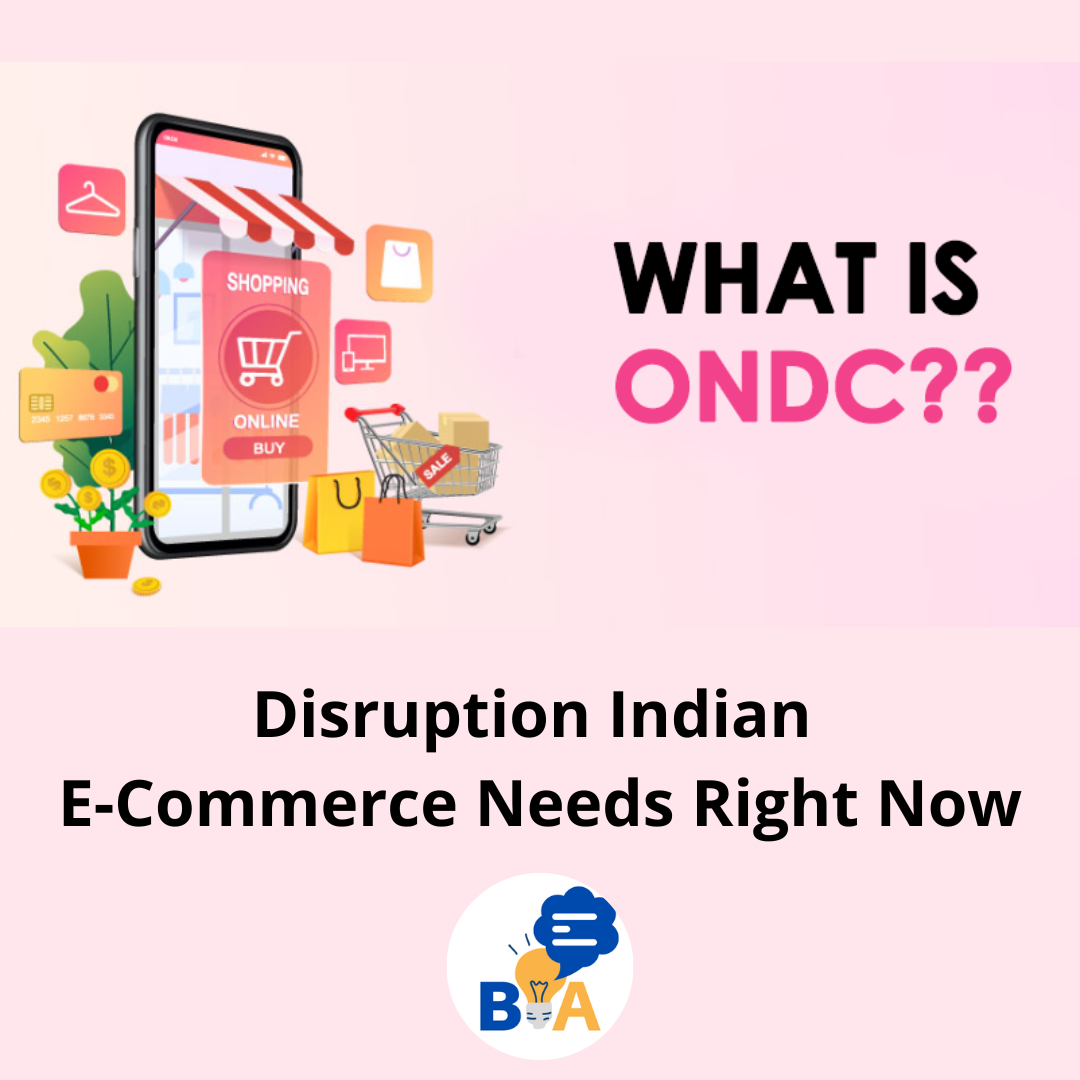ONDC – Disruption Indian E-Commerce Needs Right Now
On the 8th of May 2022, the government of India launched a pilot phase of something called the open network for digital commerce or ONDC this is a freely accessible online system for traders and consumers and the reason why this is very important is that the government intends to break down the digital monopolies and duopolies of giant tech companies like Amazon, Flipkart, Zomato, Swiggy and other companies on one side while a legend like Mr. Nandan Nilekani himself is associated with this initiative on the other side. Mr. Anand Mahindra himself had all praises for the ONDC initiative. This is expected to be as revolutionary as UPI.
We must understand what the major problems in the market are that prompted the government to start the ONDC initiative & how will it promote the small sellers and businesses against giant companies like Amazon, Flipkart and most importantly what are the most difficult hurdles that could turn this very same initiative into a flop project.
The first thing we need to know is why is there even a need for ONDC you see we already have super high-tech companies who have invested billions of dollars into researching and developing world-class tech for e-commerce in India right then why is the government trying to intervene.
Well, there are specific reasons for that, and all these reasons come under the umbrella of just one factor which is the abuse of aggregator superpower, so the question is what problems are associated with aggregator superpower
This problem comes from the monopolizing model of e-commerce.
In India, there are two important models of E-commerce through which these companies operate the
- Inventory model
In the inventory model, the company procures products in massive quantities from the sellers at an ultra-cheap rate to sell it directly to the customer
- Marketplace model
The marketplace model is the model wherein there are independent buyers and independent sellers, and the e-commerce company merely acts as a platform to connect them through their website and mobile app.
So if you see if an E-commerce platform wants to make money it by default has to buy products at a dura cheap cost and then increase its own margins in the case of amazon had two companies called Arpaio retail and Cloudtail these are nothing but huge sellers through whom amazon bought its products stored them and sold them in the market in fact there was even an investigative report that stated that cloud tail and Apario retail alone contributed to 35 of the total sales on Amazon India and they even use these sellers to strike exclusive deals with smartphone companies like apple Xiaomi and other tech companies to outplay both smaller players and their rivals.
In 2016 the government of India came out with a regulation that stated that amazon and other foreign e-commerce companies cannot use the inventory model and must use the marketplace model to operate in India which was a bit of relief for a few players and retail stores.
E-commerce companies will always find a way to increase their profits so there is a dire need to do something to promote micro and small sellers this is the first reason for the ONDC initiative.
Deep Discounting –
Main reason that we all know is nothing but deep discounting. As you all know 3,000 rupees watch is available for 1,500 rupees water purifier worth 25 000 is available for 10,000, Branded apparels and shoes have 60 to 80 discount and so on and so forth these. Even the discounts and prices during Diwali and big sales days are insane. These sales and offers directly hurts the brick-and-mortar stores who are not able to match these deep discounts so the second reason for ONDC is deep discounting that is hurting the offline commerce economy which to us it may seem outdated but from the government standpoint it is an important part of our economy so the government cannot neglect it.
The imitation game –
Imitation game of e-commerce platforms amazon is under investigation in the United States, Europe and India for alleged anti-competitive practices that hurt other businesses.
Amazon has repeatedly been accused of knocking off the products of sellers in its marketplace and rigging search results and exploitation of its vast trove of data to promote its own merchandise at the expense of other sellers.
Long story short, Amazon replicates the highest selling product, manufactures the same by striking a deal with a local manufacturer, and list the same as a best seller. With this power and bulk manufacturing, Amazon can provide deep discounts and keep the consumers tied to their own brands. Few brands in India are Amazon Basics, Solimo, etc.
What is ONDC and how will this help?
Let’s try to understand how the government is trying to solve this problem using the ONDC initiative. ONDC is basically a three-legged stool first is discoverability the second leg is open protocol for e-commerce platforms and interoperability and the third leg is price comparison.
So let’s try to understand each one of these legs using a scenario let’s start with the first leg which is discoverability today if you want to shop for a Microwave you will either look for it on amazon or Flipkart why only these apps because you’ve downloaded them you’ve fed your card and address details in it so by default because of this investment that you’ve made you will rarely consider the possibility of going elsewhere and more importantly if you’ve got amazon prime then the question of Flipkart also doesn’t come into play but with ONDC. if you look for the term Microwave you will see the item from hundreds of other e-commerce platforms and here’s where you might discover an enterprise like E-Samuday which is a tech start-up that has digitalized your local electronic store in your Neighbourhood you can buy Microwave at doorstep with the cheapest cost and even get it delivered within just two hours so in short, you will have a unified search feature wherein you can get the products from all e-commerce sites without having to download them and without having to switch from one side to the other
The second leg is interoperability for this let’s take the simple example of delivery choice let’s say you want to order Biryani now when we use Zomato although Zomato gives us an amazing advantage of getting all the restaurants listed on a single platform if Zomato decides to charge a higher delivery cost then you can’t do anything and this is because Zomato might have lesser delivery boys in a particular area and if Zomato does not have any delivery boys in that particular restaurant’s area then you cannot place the order but with ONDC even delivery companies will be listed along with aggregators customers and restaurants so ONDC will tell you that Zomato delivery guys are not available but Dunzo delivery agents are available in that area so you can place your order through Zomato but have it picked up by Dunzo or you can directly ask your dunzo or any other delivery partner to pick up your order from the restaurant. Similarly, you can place your order through e samuday which has all the moment pop stores listed, and get it delivered by dunzo. So, this way there is a huge lacuna that the delivery companies can fulfill which will further prevent companies like Zomato and Swiggy from monopolizing the delivery space.
Lastly, we have a price comparison feature, I am sure you must have used or known about Sky Scanner for flights or Trivago for hotels. hundreds of websites had
hundreds of hotels listed with different prices so trivago came in and said hey, you choose the hotel and we will list all the prices from all the websites, and then you can choose the most economical option of all this is exactly what ONDC intends to do for e-commerce so if amazon secretly pushes up its prices you will not be blindsided by amazon’s ecosystem and you will actually have the opportunity to see other e-commerce companies with a lesser cost this is how the government intends to empower merchants and consumers by breaking the SILOS to form a single network to drive both innovation and skill eventually transforming all the businesses from retail goods foods to even mobility.
It might look like an amazing idea but if you look at the fighters in this prize war you will see that we have big companies like Dunzo and Zomato and on the other side we’ve got smaller local aggregator services now over here Zomato or Dunzo would take another billion dollar funding and it will undercut all its competitors by which these smaller players will be forced to actually decrease their costs eventually those companies will run out of cash and then be out of business so this way the purpose of price comparison could be defeated if bigger players engage in predatory pricing and lastly after all the cash drain that Amazon Zomato have engaged in after they have spent thousands of crores with the hope of becoming profitable now the government itself is actually closing down their avenues of profits and this could be a disaster for example Zomato now cannot open up its own cloud kitchen because it apparently looks like anti-competitive. Zomato has a good chance of making money through delivery because it could use its platform advantage to actually rack up the prices but now through ONDC it might have to compete with dunzo so so even delivery price has to go down so at the end of the day this gold mine of data that Zomato , Swiggy and amazon like companies have that’s not being unleashed for profit at all and this creates a paradox so if these companies run profitably sellers and restaurants might face losses but if they don’t run profitably since they have a billion dollar funding the logistics companies and the small aggregators will face losses and I have no idea how ONDC is going to solve these problems.
Let’s hope ONDC is executed successfully, and Indian E Commerce will be model for all western countries.


Dear Bunty,
Thank you for sharing this very lucid and clear understanding on ONDC and it’s impact. My view is that with ONDC’s first feature…Discoverability , many small but innovative product companies will get visibility and thus increasing their chances of success. The second feature INTEROPRABILITY will reduce the delivery bottlenecks thus again facilitating small time innovators to find better delivery channels to reach their products to deserving customres. These two features will help in breaking Market Mono/duopolies of Predators and provide space and opportunity for small players to flourish thus boosting local/micro innovations.
Finally the third feature of Price Comparison , I feel is more for mass consumption products and with current situation of global economy, i doubt even large organizations will be willing to burn money on deep disounting, as there is always a risk of Loyalty shifts by consumers the moment the discounts are off.
Thanks a lot for your comments